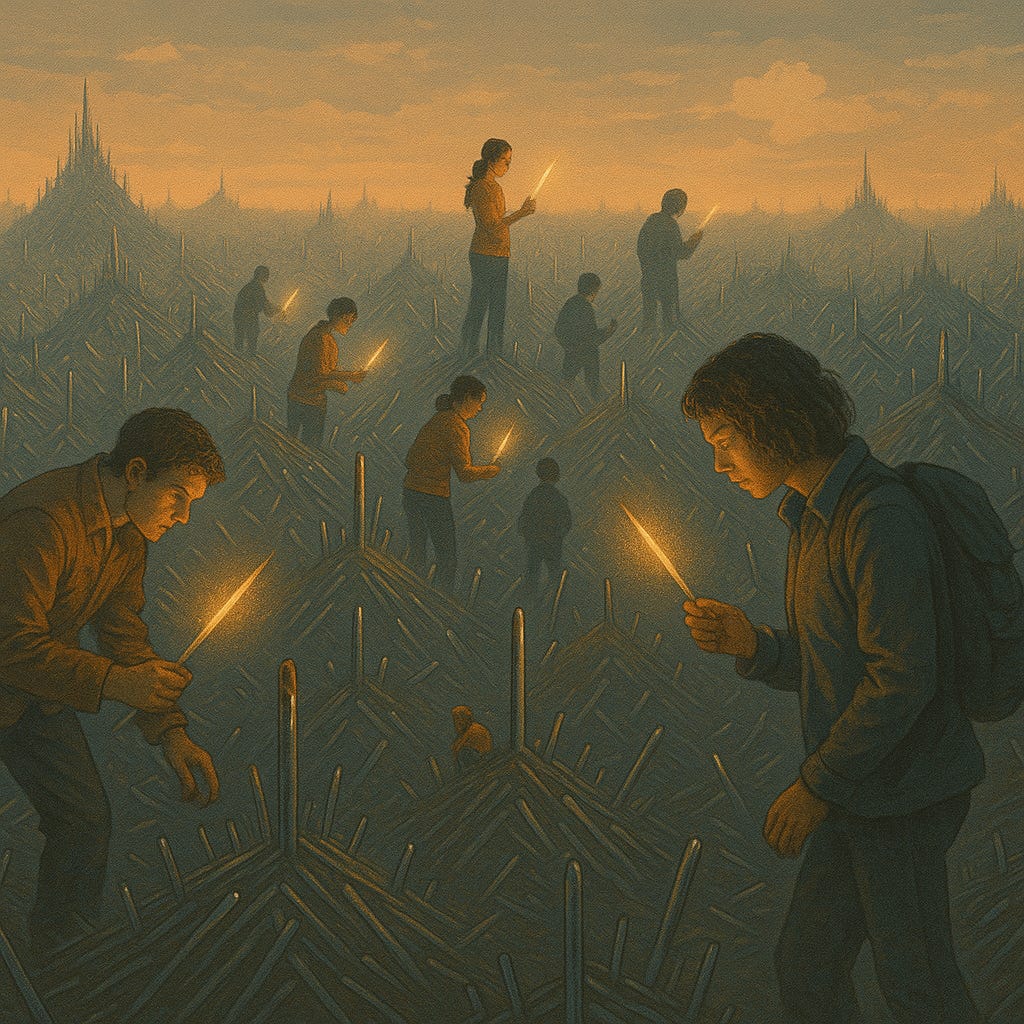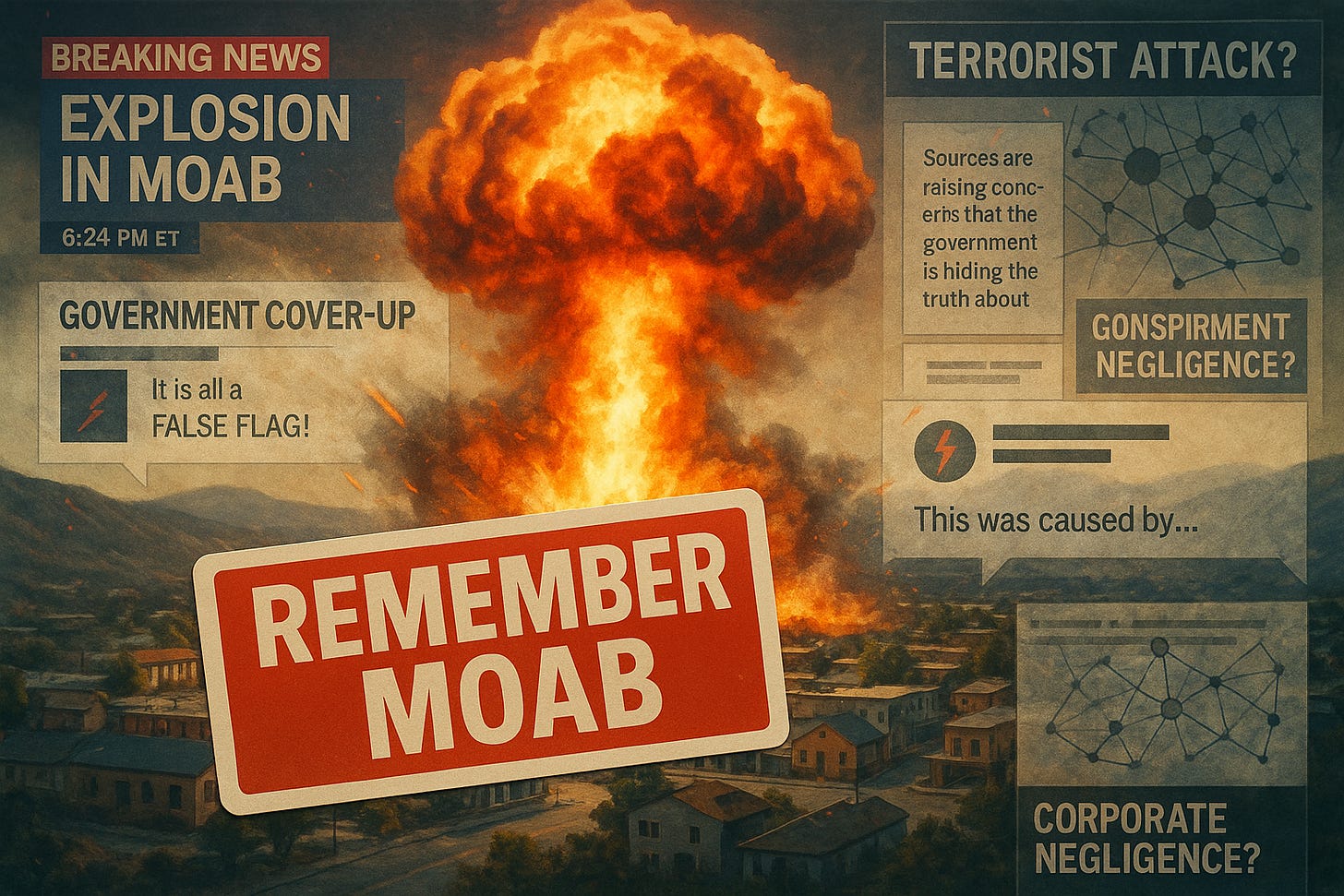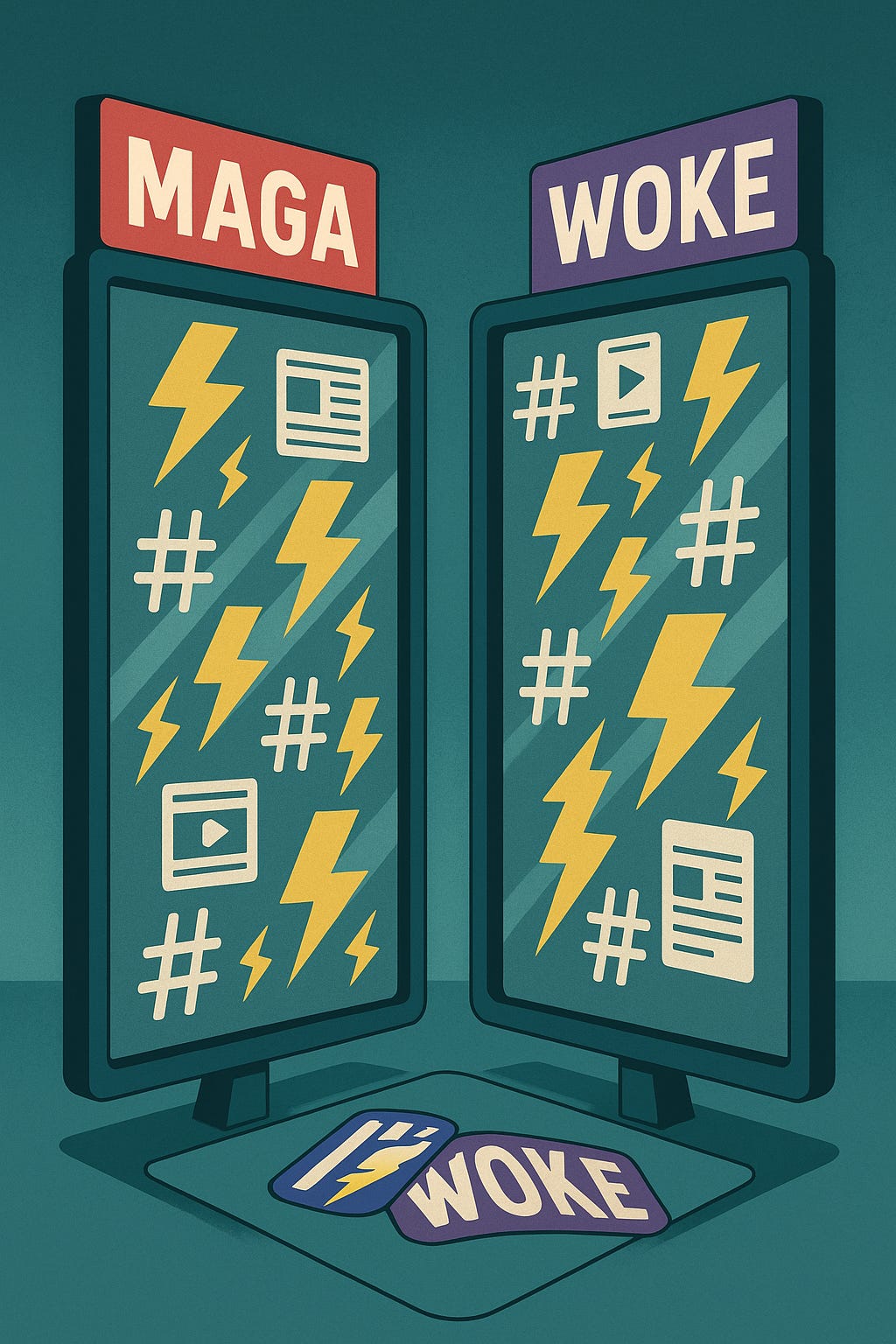When the kids ask what happened to the United States, do not start with parties or presidents. Start with the shift. Reality stopped being something we tested together and became something we felt alone.
It was so fast we didn't even realize it had changed. The shift was not from fact to lie, but from method to mood. What counted wasn't what was proven but what was felt most sharply.
REMEMBER MOAB!
A REMEMBER MOAB! is a high-charge narrative that outruns its evidence; emotional velocity beats factual gravity. Each essay spots a REMEMBER MOAB!, then runs the Lab to slow, measure, and correct.
Working model: ax + by = c. Solve for E (emotion signal) and R (reasoned evidence) together; do not zero a term to make the math easy. The coupling must be visible: a per-100 base rate beside the claim and a written falsifier. No coupling means rationalization.
We did not enter a digital age. We entered the needle‑stack. A haystack had one needle worth finding. Experts hunted it and popped the balloon of confusion. Now the stack is all needles. Anyone can grab one and pop any balloon. Facts still exist; selection changed. Feeling picks which facts count.
Moab math: the two-variable rule
Write the decision as ax + by = c.
E(x) is the felt signal: threat, pride, disgust, fear.
R(y) is the checked evidence: primaries, base rates, dated tests.
a and b are the weights you actually use, not what you claim.
c is the action threshold: post, march, buy, fire, vote.
The common failure: set b = 0 in practice and call it “conviction.” The repair: keep E as a sensor; pair it with R in writing. Show the coupling with two items next to every hot claim: a per-100 base rate and a one-line falsifier with an update window.
This transformation wasn’t abstract. It played out in real time, in real places, with real consequences. Consider what I’ll call the “Remember Moab” pattern—a composite of how dozens of similar incidents have unfolded across America in recent years. “Remember Moab” names the pattern, but most readers have not met it at the source. Here is the source.
Neal Stephenson’s novel Fall; or, Dodge in Hell opens with a fabricated nuclear blast over Moab, Utah. Sirens, plumes, evac routes, and news crawls spread across feeds—built from real signals glued together by skill and malice. Competing narratives emerge at once: government cover-up, terrorist attack, false flag. Traditional fact-checking begins, but it is too slow. The hoax works because it feeds outrage faster than truth can respond.
In Moab terms: a is high (E spikes), b is low (primaries lag), so ax + by crosses c and people act. If you do not publish a base rate and a falsifier, you have hidden the coupling and invited error.
This wasn’t just a hoax that fooled people. It was a self-assembling myth that didn’t need to fool anyone. The actual facts of what happened became secondary to what people needed the event to mean. Those who wanted to believe in government conspiracy found their evidence. Those who suspected foreign interference found theirs. Those who blamed corporate negligence found confirmation too.
The pattern repeated everywhere: suspicious deaths, disputed elections, disease outbreaks, mass shootings. The internet made every citizen an investigator, but it also made every investigation tribal.
Stephenson’s point is not that people are dumb. His point is that incentives beat lectures. Moab thrives because the system rewards content that carries a charge. A fake that fits a tribe’s priors spreads faster than a correction that fits nobody’s mood. A cover story that flatters the in group beats a footnote that humbles it. Once a myth offers community, truth has to offer more than facts to compete.
This is why “Remember Moab” is the right emblem for our era. It is a compact way to name an exploit: a single charged story that reorders identity, monetizes rage, and outlives its debunking. You can swap in other tokens and the function is the same. Remember Wuhan. Remember Vaccines. Remember the Stolen Election. The list grows because the logic pays. The label changes. The loop holds.
This expansion matters for the rest of this essay for one reason. We are not arguing about a book. We are naming a system pattern that repeats with new nouns. Once you see Moab as a reusable exploit, you can see why each camp insists its token is sacred while the other’s is delusion. The symmetry hides in plain sight.
And that’s the final move: break the link between fact and consequence because b went to zero in practice. When reputation replaces reference, slogans rule.
Procedure dies. Slogans calcify.
This is what changed:
Valence took the wheel. People stopped asking what happened. They asked how it made them feel. Threat, pride, disgust, fear. The measure of a claim became its charge.
Distance collapsed. Print let us pause. Screens collapse time into now. When everything is live, instinct beats reflection.
Procedures leaked. We once had shared steps for settling a claim: define it, check sources, update in public. That habit thinned out under speed and performance.
Coupling vanished. We kept E and dropped R from the written rule. ax + by = c became ax = c. The action stayed; the test disappeared.
From that day forward, Moab is not an event. It is a proof text. People put REMEMBER MOAB on bumper stickers. Conspiracy channels build careers around timelines and map overlays. A subculture forms that treats denial of the blast as heresy. Years pass. The slogan remains. The details mutate. The heat does not.
Social media algorithms amplified the loudest voices. Echo chambers replaced newsrooms. Emotional intensity became the currency of attention. Each element broke a different stabilizer in our collective sense-making system. Together, they killed the circuit that once connected evidence to belief.
Once our filters became keyed to emotional intensity rather than logical coherence, truth-seeking became tribal. We stopped testing our beliefs against people who disagreed with us. We started testing them against people who would confirm what we already felt. The center (that shared space where we once argued about evidence rather than reality itself) dissolved.
What fell first was not a branch of government or a democratic institution. It was coherence: the hard-won habit of testing our claims with people who do not love us, who do not share our fears, who do not want us to be right.
Without that habit, every balloon seemed equally worth popping. And in a stack of infinite needles, the truth became whatever hurt most.
So we split. Not into two nations, but into two mirrors. MAGA and WOKE are less camps than methods: each protects moral certainty with the same moves. Signal the harm, rally the in group, treat dissent as malice, reward the loudest. The language differs; the incentives match.
I find the arts (humor) has recognized the impact of the hidden force shaping our new post-rational era (you must name a demon to control it and best to use humor in the naming). To see a Brad & Chad Best Friends Forever video. No real spoilers are given and only 1:44 long. BEST TWO MINUTES YOU’LL SPEND ON YOUTUBE GUARANTEED!
Keep reading with a 7-day free trial
Subscribe to Wayne’s Substack to keep reading this post and get 7 days of free access to the full post archives.




